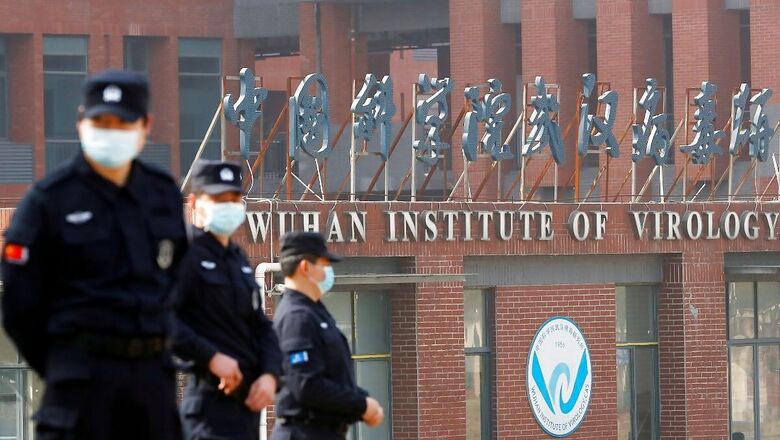
views
It should have been the last act in the tragic drama the world has witnessed, but it appears to merely have been the Act II. The 319 page report of the World Health Organization (WHO) investigation into the origins of SARS-CoV-2 virus that led to the COVID-19 epidemic has not satisfied anyone and it is unlikely that we will ever get to see the curtains come down on the issue. Further investigations are promised, but they are not likely to get anywhere.
Meanwhile, a pandemic that ought to have been met by a unified global response, continues to divide the global community and remains grist for the political mills. From the outset, the issue of the origins of the virus has been politically fraught and entwined with the acrimony between the US and China which intensified through 2020. The very investigation was the end product of a detailed negotiation between China and the WHO. For this reason, the WHO had to deal with the issue as a diplomatic mission, rather than a scientific investigation, indeed, the Chinese insist that it is not even an investigation, but “a scientific joint study” to trace the origins of the SARS-CoV-2 virus. That is why this is not a purely WHO report, but one written by a joint team comprising of 17 WHO appointed experts and 17 Chinese scientists. The team had a limited four-week time frame with restrictions on access to material. This meant that the team could not conduct a forensic examination of the labs, pore through lab notes, freezers, data bases and so on.
In his briefing, the WHO Director General Tedros Adhanom Ghebreyesus, who has been accused of being soft on Beijing, was actually critical of China. He said that while the team reported that the first cases were detected on 8 December 2020, but scientists would need full access to the data “Including biological samples from at least September 2019.” He said that his discussions with the WHO team had brought out the difficulties in accessing raw data. The team had also visited several Wuhan labs to consider the possibility that the virus was a result of a laboratory accident. However, the WHO chief noted that “this assessment was [not] extensive enough” and more data was needed to arrive at “robust conclusions.” He said though the lab-leak theory was considered the least likely hypothesis, “this requires further investigation” by specialists which the WHO was ready to deploy. These remarks were underscored by the leader of the WHO team Peter Ben Embarek, who said “We’ve only scratched the surface of this very complex set of studies that needs to be conducted.”
The report has recommended further studies into the evidence, including the Chinese hypothesis that the virus may have been circulating in other countries, including the US, and came to China via frozen food. As part of its work, the report also looked into another hypothesis pushed by Beijing that the virus came through 7th World Military Games held in October 2019. However, an annex of the report notes that “nothing resembling COVID-19 had been seen” at the clinics servicing those games.
The report considered four major theories of origin:
1) The most favoured “likely to very likely” hypothesis is that it jumped to people via an intermediary species. The virus was first found among people who had worked or had visited a market in Wuhan.
2) That the virus jumped from bats to people, but the report said that a sampling of bats in Wuhan did not find the SARS-CoV-2 virus.
3) That the virus was released accidentally by a lab studying coronaviruses, but this is rated as “extremely unlikely”.
4) That the virus came via frozen food, an idea that had been pushed assiduously by China. The report said this was “possible”, but required much more investigation.
Given its reluctance to provide data and access to the WHO team, it is unlikely that China would acquiesce to deeper and more detailed investigations, even if those are in pursuit of its own hypotheses.
At the official level, speaking just before the report was publicly released Chinese foreign ministry spokeswoman Hua Chunying, first took the high ground insisting that “the issue of origin tracing is a scientific one that should be left to scientists.” But she could not resist noting that “there is still a big question mark over the lab at Fort Detrick.” In fact, she herself had in January revived the theory put out by the Chinese last year that the US army lab at Fort Detrick was the origin of the virus. Admittedly, this had been in response to an equally irresponsible “fact sheet” put out by the Trump administration alleging that the source of the virus was the Wuhan Institute of Virology. Neither Hua nor the US State Department had backed up their assertions.
Meanwhile 14 countries, all close allies of the US ranging from Australia, Canada, Norway, Japan, UK, and Israel, put out a joint statement voicing their “shared concerns” that the report “lacked access to complete, original data and samples” and went against the efforts to produce independent and objective assessments. They pointedly called for independent experts to get “full access to all pertinent human, animal, and environmental data, research, and personnel involved in the early stages of the outbreak” with a view of determining its origins. Significantly, France, Germany, and New Zealand were not signatories to the statement which also included all three Baltic republics, Czechia, Denmark, and Slovenia. In her official response, the Chinese official spokeswoman Hua Chunying accused these “handful of countries” of negating the WHO effort and said this would actually hamper the process of tracing the origins of the virus and the anti-pandemic cooperation. She suggested that instead of focusing on China alone, the report has indicated the need for “origin tracing work in multiple countries and sites.”
Beyond the issue of the WHO report and the origin of the SARS-CoV-2, what is new is the strong assertion of the United States global leadership on ways and means of dealing with the pandemic. The Trump administration’s handling of COVID-19 was shambolic, to say the least. Recall that in a massive tantrum, the US withdrew from the WHO in July 2020. Among the first actions of the Biden administration was to rejoin the organization. And now it is demonstrating that not only is it willing to assume its traditional responsibilities as a global power in relation to public health issues, but will also take along its closest allies in the process.
This story has not ended, just as the COVID-19 pandemic hasn’t. The scientific community will continue its search for the origins of the virus. But at the political level, the story has taken on a life of its own. It has provided the United States and its allies a rallying point. Note the centrality, at least in the public posturing, of the Quad. In its first ever summit last month, the Quad focused on the importance of dealing with the COVID. Its plan to use India as a manufacturing base for vaccines developed in the US, and have Japan finance the whole process, is an inspired one. In the process, the Quad countries plan to expand their strategic goals into a larger competition with China involving emerging technologies and infrastructure financing as well, and thus, build equity among regional countries who do not have an appetite to take sides on a China versus US security competition.
This article was first published on ORF.
Read all the Latest News, Breaking News and Coronavirus News here. Follow us on Facebook, Twitter and Telegram.




















Comments
0 comment